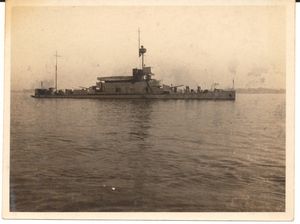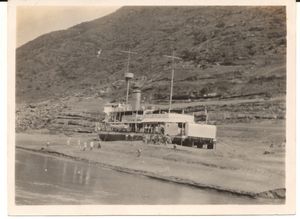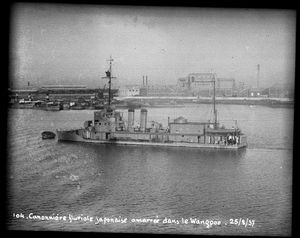| River Gunboats: China |
| River gunboats were often used by the major powers to protect their interests overseas – trade, shipping, property and individual citizens - from local conflicts, piracy and other hostile acts. Two typical examples were the use of such craft in China, under the terms of the various treaties concluded after the Opium Wars, and in a more traditional colonial role in French Indo-China. Such warships were typically shallow-draft vessels, strongly-built to support the rigours of navigation in rivers strewn with sandbanks and rapids. For its size, the river gunboat was well-armed with one or two small or medium calibre guns and light machine guns. The larger river gunboats had a complement of such size as to be able to land an armed force of officers and men to make a show of military strength and, if necessary, to contain the situation until reinforcements arrived or diplomats reached a solution. This topic is divided into two parts; River Gunboats: China and River Gunboats: French Colonies and others. Many of the illustrations and an extensive part of the text of River Gunboats: China were contributed by Graham Thompson. | |||||||||||||||||||
|
Catalogue number The Graham Thompson Collection Unknown Insect class gunboat, Yangtze circa 1928 In the early 20th century, the British, American, French, German and Japanese navies all maintained gunboat patrols in Chinese waters. Austro-Hungarian, Italian and Portuguese vessels were also sometimes deployed. This was a tumultuous period of Chinese history, and their role was to protect each country's interests, primarily shipping and trade, as well as individuals such as missionaries. The Yangtze River patrols, operating from 1900 to 1941, covered this river from its mouth near Shanghai to Chongqing, 1400 miles inland, and beyond, as well as various tributaries. The West River patrols, operating from Canton (now Guangzhou), worked the river to the west of the important southern city. This photo is a classic image of an unknown Insect class gunboat “somewhere on the Yangtze”, around 1928. Its modern industrial lines contrast dramatically with the traditional designs of the sampans and junks in the foreground. The gun on the foredeck is also a reminder of what the gunboat could do in the event of trouble. 28.5cm x 22.5cm Gelatin silver print |
 |
||||||||||||||||
|
Catalogue number The Graham Thompson Collection Map of the Yangtze This small sketch map, from a collection of material coming from the gunboat H.M.S. Sandpiper, shows the Yangtze from just outside Shanghai to Chongqing (then Chungking), and the locations of major ports. The Royal Navy had been involved in charting the river from the mid 19th century. Steamer navigation was first achieved on the most difficult section between Yichang (then Ichang) and Chongqing in 1900 by the merchant skipper Samuel Plant, on the small vessel 'Pioneer'. This was specially built for the attempt under the supervision of Archibald Little, a noted China businessman. With the outbreak of the Boxer Rebellion in the same year, the ship was then taken into military service as H.M.S. Kinsha, and became the first flagship of the Yangtze patrols, serving until 1921. 10.3cm x 9cm Gelatin silver print |
 |
||||||||||||||
|
Catalogue number The Graham Thompson Collection H.M.S. Teal dressed over One of the first generation of Yangtze gunboats were H.M.S. Teal and her sister H.M.S. Moorhen, which were slightly larger versions of their immediate predecessors H.M.S. Woodcock and H.M.S. Woodlark. They served on the middle and upper river between 1901 and 1931. These were not large vessels, displacing only 85 tons. They were armed with two 6-pounder guns and four single machine guns, and had a draught of 2 feet. These vessels had few modern comforts, originally with no electrical power and for “comfort” nothing more elaborate than canvas screens around earth closets. However, these deficiencies were made good by 1908. The patent for their design was bought by the U.S. government and later used for their gunboats U.S.S. Palos and U.S.S. Monocacy. This image shows H.M.S. Teal “dressed” for some special occasion, perhaps The King's Birthday, when the ships would typically moor up at one of the ports on the river and entertain, and be entertained by, the local British community. Verso: "HMS Teal" 10.3cm x 5.8cm Gelatin silver print |
 |
||||||||||||
|
Catalogue number The Graham Thompson Collection H.M.S. Bee, flagship of the Rear Admiral Yangtze This is H.M.S. Bee, a modified Insect class that served on the Yangtze from 1918 to 1939, having been in Mesopotamia from 1915 to 1917. From 1927, she was also the flagship of the Rear Admiral Yangtze, commanding the British Yangtze patrols. The vessel's 6-inch guns were removed to provide space for extra accommodation and offices for the Admiral and his staff (not visible here in this view from the bow, but see the later photo of the same ship below). Note also the Rear Admiral's flag, with two red circles in the quadrants of the ensign at the mast. The distinctive two funnels of the class, mounted abreast, are clearly visible in this view. The ship's were painted white overall, with yellow funnels. The vessel came under fire from Japanese artillery off Wuhu on 12 December 1937, the day the U.S.N. gunboat U.S.S. Panay was sunk. H.M.S. Bee was scrapped in Shanghai in 1939. 5.6cm x 8cm Gelatin silver print |
 |
|
Catalogue number The Graham Thompson Collection H.M.S. Scarab H.M.S. Scarab was an Insect class that served on the Yangtze between 1918 and 1941, after service in Mesopotamia 1915 to 1918. After China, she was transferred to the Mediterranean for the remainder of WW2 and was scrapped in 1948. The Insect class were the mainstay of the Yangtze patrols into the 1930s. With three rudders, they were very manoeuvrable. In the early 1920s their steering gear was strengthened, which gave them an even tighter turning circle, a necessity in the gorges or to avoid collisions with junks and sampans. The only real drawback, compared to earlier British gunboats, was their much greater displacement of 645 tons and slightly deeper draught of 4 feet. This meant they could only make it through the gorges into the upper river near Chongqing in the summer months, when higher water levels allowed. The protective canopies visible in this view suggest it was taken in the summer. 7.7cm x 5.8cm Gelatin silver print |
 |
||||||||
|
Catalogue number The Graham Thompson Collection H.M.S. Gnat A good clear shot of H.M.S. Gnat, another stalwart of the Yangtze patrol from 1918-1940. Again, she spent some time in Mesopotamia before China, and the Mediterranean afterwards. She was scrapped in 1945. With the hot weather canopies not in place, the ship's armament of two 6-inch QF Mark I guns can be seen, as well as one of the two 12-pounder QF's just below the bridge. The aft 12-pounder was often replaced by a 2-pounder pom-pom. Six Lewis guns were also carried, mounted on twin mounts, three on each side on the screen deck amidships. When navigating in the upper reaches of the Yangtze, H.M.S. Gnat was a formidable example of the naval power that she represented, i.e. the Royal Navy. "I may be little but I represent something very big!" she seems to be saying. Verso: "HMS Gnat" 9.8cm x 7.3cm Gelatin silver print |
 |
||||||
|
Catalogue number The Graham Thompson Collection Negociating the Hsin T'an rapid The hazards to navigation on the Yangtze were many and varied. This photo is taken from a small book (Excelsior - being an inadequate description of the Upper Yangtze, 1934, North-China Daily News and Herald, 1934) written by Commander D.B. O'Connell(under the nom de plume of 'Charon', who commanded H.M.S. Gannet on the river 1926-1928. Illustrated is the Hsin T'an rapid, just west of Yichang, which the author describes as “one of the most unpleasant of the low level rapids”. The owner of this copy of the book, probably another gunboat or steamer crewman, has added his own comment and the route in ink. He adds, “the pen line shows track, but it must be remembered that the ship's head must be kept pointing up river all the time – otherwise, she'd be swept away bodily. It is almost twice as bad during January – we heave over it during that month”. January is of course low water for the Yangtze, and by heaving over he means being physically pulled over the rapids and along the edge of the river by a large team of Chinese “trackers”. |
 |
||||
|
Catalogue number 80411 Japanese gunboats on the Yangtze, August 1937 Of course, there were other navies operating on the Yangtze. These vessels are from the Seta class of four such Japanese craft, all serving from 1922 to World War Two, mainly between Shanghai and Hankow. These two are seen here on the Huangpu River at Shanghai, soon after the outbreak of Sino-Japanese hostilities at Shanghai in August 1937. Their design was quite similar to the earlier British Woodlark class and the American Palos class. They were armed with two 3-inch guns and six machine guns, and had a draught of 3 feet 4 inches. The ships were not ocean-going, and were thus shipped in sections from Japan to Shanghai and re-assembled there. Seta served with the Republic of China navy in the late 1940s, and the People's Liberation Army Navy from 1949 until 1960. The other three vessels were lost during WW2. 5.4cm x 4.3cm Cellulose negative |
 |
||
|
Catalogue number 105046 French Navy gunboat Doudart de Lagrée, Shanghai The French Navy, too, maintained a presence on the Yangtze, and this photo shows the gunboat Doudart de Lagrée alongside at the Kiousin dockyard of the Société Franco-Chinoise des Constructions Métalliques et Mécaniques, Shanghai. She and her sister ship Balny served between 1922 and WW2. They were armed with one 3-inch gun, two 37mm gun, and four machine guns. They had a displacement of 183 tons and a draught of 4 feet 3 inches. Before these two, the French presence on the Yangtze was comprised of the Argus and Vigilante, between 1900 and around 1914, as well as the Orly between 1901 and 1909. Later additions included the sloop Alerte from 1922 to 1936, and the 'Frances Garnier' from 1927 to 1939. The latter was an impressive 640 tons and served as flagship of the French flotilla. Verso: "Doudart Kiusin" in pencil 5.6cm x 9cm Gelatin silver print |
 |
|
Catalogue number The Graham Thompson Collection Royal Navy landing party, Hankow 1925 A regular function of the gunboats of all nationalities was to put ashore landing parties to protect their civilians and business interests [see the topic The Navy Landing Party"]. This photo shows a Royal Navy landing party ashore at Hankow in mid-June 1925, after riots erupted following the shooting of Chinese students by Shanghai Municipal Police during disturbances there on 30 May. The sailor at the right, behind the Maxim machine gun on its wheeled mount, is from H.M.S. Gnat, according to the hatband round his tropical helmet. Some of the others may also be from the same vessel, or from other RN ships in port. Note also the Lewis guns on the ground to the right of the group. 14.5cm x 9.4cm |
 |


















